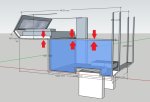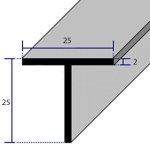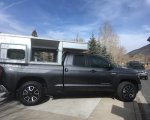Buildingfreedom
New member
Hello from Italy, forum.
I’m about to build my own camper box on the back of the truck version of the vw T5 4motion van.
So I’d like to get some help from the veterans here.
Sadly, I have to respect the severe limitations about the allowed weight, because of the driving license limits that we have here in Yurop, wich limit the GWVR to (3500kg) approx. 7716lbs.
My basis truck’s payload (already considered 3 the passengers in the turck’s cabin) is less than 2750lbs (1150kg).
Dimensions:
L 173 inc (4400mm)
W 94,5 inc (2400mm – but I m not sure about this)
H 92 inc (2340mm)
including the cabover that is about 78,8 inc long and 39 high.
Must have a tetfhord toilet, 100lt of fresh water, a shower and all the usual rest (TV included), which is a lot of weight, I think.
I made a rendering, extremely simplified, just to give an idea (I suck with sketchup).

My main problem is the safety and stability of the cabover. It must be strong enough to support, in a static condition (aka not while I’m driving), the load of 880lbs (400kg), wich is composed by the insulation material (like armaflex sheets), internal trim, the double bed composed by a mattress of the same type used at home, and of course the weight of 2 persons.
I just don’t trust by default to rivet 2 bars of aluminum, each one long about 78,8 inc and attached with just 2 angular (90°) segments.
So I have decided to use a bar wich is located in the left side and which is long like the camper box itself; in the pic it's highlighted by red arrows.
Such bar will be kept down by a series of vertical bars that are not portrayed in the pics, each one riveted with angulars.
What do you think about this topic and about my idea? Is such long bar strong enough to guarantee the safety of the cabover?
Then, about the material, at first I wanted it to be 40x20x3mm aluminium boxed bars, but a friend who is expert in carpentry (only by indirect experience, he drives machines amd has no school or uni titles) told me to use instead 40x40x1mm.
What do you think about the materials I should use? Which option is the best for my project?
Thanks for cheking my post.
I’m about to build my own camper box on the back of the truck version of the vw T5 4motion van.
So I’d like to get some help from the veterans here.
Sadly, I have to respect the severe limitations about the allowed weight, because of the driving license limits that we have here in Yurop, wich limit the GWVR to (3500kg) approx. 7716lbs.
My basis truck’s payload (already considered 3 the passengers in the turck’s cabin) is less than 2750lbs (1150kg).
Dimensions:
L 173 inc (4400mm)
W 94,5 inc (2400mm – but I m not sure about this)
H 92 inc (2340mm)
including the cabover that is about 78,8 inc long and 39 high.
Must have a tetfhord toilet, 100lt of fresh water, a shower and all the usual rest (TV included), which is a lot of weight, I think.
I made a rendering, extremely simplified, just to give an idea (I suck with sketchup).

My main problem is the safety and stability of the cabover. It must be strong enough to support, in a static condition (aka not while I’m driving), the load of 880lbs (400kg), wich is composed by the insulation material (like armaflex sheets), internal trim, the double bed composed by a mattress of the same type used at home, and of course the weight of 2 persons.
I just don’t trust by default to rivet 2 bars of aluminum, each one long about 78,8 inc and attached with just 2 angular (90°) segments.
So I have decided to use a bar wich is located in the left side and which is long like the camper box itself; in the pic it's highlighted by red arrows.
Such bar will be kept down by a series of vertical bars that are not portrayed in the pics, each one riveted with angulars.
What do you think about this topic and about my idea? Is such long bar strong enough to guarantee the safety of the cabover?
Then, about the material, at first I wanted it to be 40x20x3mm aluminium boxed bars, but a friend who is expert in carpentry (only by indirect experience, he drives machines amd has no school or uni titles) told me to use instead 40x40x1mm.
What do you think about the materials I should use? Which option is the best for my project?
Thanks for cheking my post.







